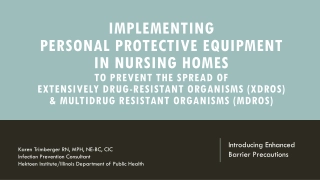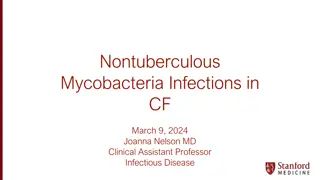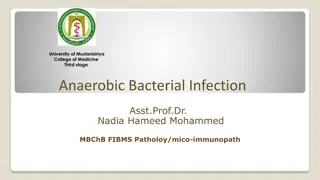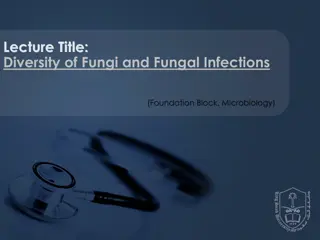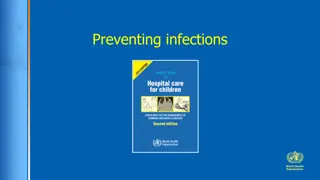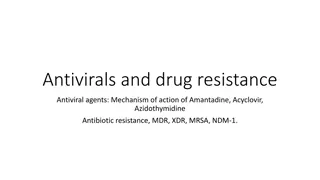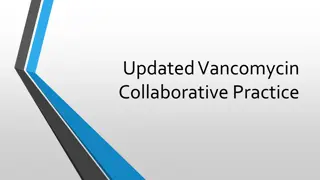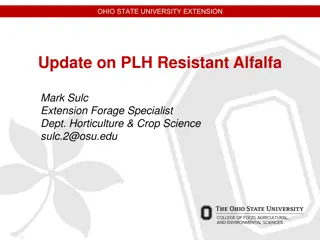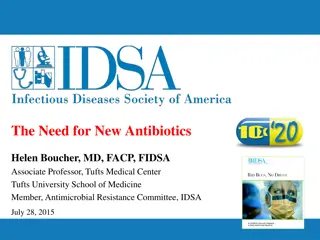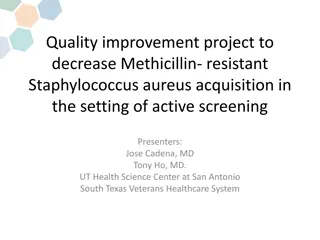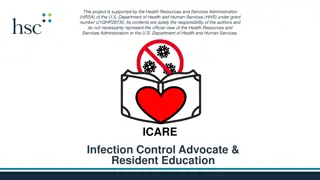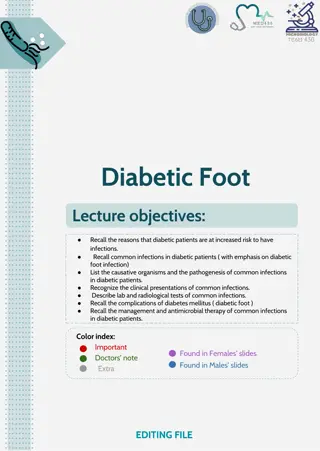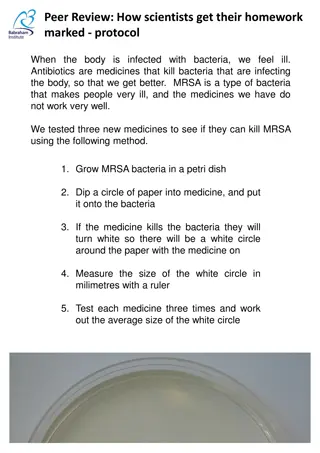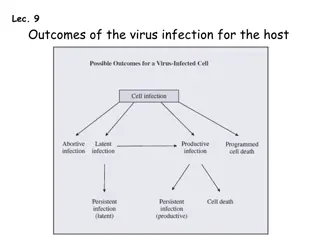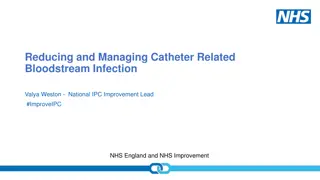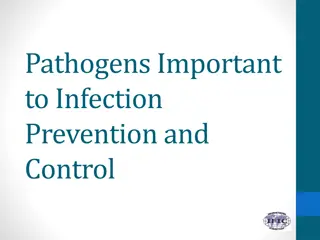MRSA: Methicillin-Resistant Staph Infections
MRSA, or Methicillin-Resistant Staphylococcus Aureus, is a bacteria that causes skin infections and is resistant to common antibiotics. It poses a serious health concern, especially in hospital settings. Carriers may not show symptoms, and the bacteria can survive in various environments for extended periods. Understanding how MRSA spreads, where it is commonly found, and how to prevent transmission is crucial for controlling its impact on public health.
Download Presentation

Please find below an Image/Link to download the presentation.
The content on the website is provided AS IS for your information and personal use only. It may not be sold, licensed, or shared on other websites without obtaining consent from the author.If you encounter any issues during the download, it is possible that the publisher has removed the file from their server.
You are allowed to download the files provided on this website for personal or commercial use, subject to the condition that they are used lawfully. All files are the property of their respective owners.
The content on the website is provided AS IS for your information and personal use only. It may not be sold, licensed, or shared on other websites without obtaining consent from the author.
E N D
Presentation Transcript
MRSA Understanding M Methicillin R Resistant s staph a aureus for Environmental Services Personnel
What is MRSA? O M Methicillin r resistant s staphylococcus a aureus O staphylococcus aureus = a bacteria commonly referred to as staph . It is the cause of most skin infections. O Methicillin resistant Methicillin resistant = not killed by common antibiotics used to treat staph bacterial infections
MRSA, MRSA, MRSA O MRSA MRSA has been making headlines all over the country O MRSA MRSA has been a serious concern in hospital-based institutions for years O MRSA MRSA infections occurring outside of the hospital (community acquired) are becoming more common and create a health concern for everyone
MRSA Facts O Many people (25-35%) are carriers of MRSA on their skin and/or in their noses and do not have any symptoms O Most healthy people recover from MRSA with antibiotic treatment O MRSA can cause life threatening infections in people with weakened immune systems O MRSA can survive many extreme environmental conditions for 7 days to 7 months
MRSA on Campus O 5 Cs : C Crowding, frequent skin-to-skin C Contact, C Compromised skin (cut, scrape, or rash), C Contaminated items and surfaces, and lack of C Cleanliness O Typical college population believes they are invincible and do not wash hands enough increasing the risk of spreading infections O MRSA is commonly found in dormitories, rooms/waiting areas of health clinics, athletic/wellness areas, and locker rooms
How do people get it? O Touching infected skin (skin to skin contact) O A person with MRSA touches their wound or wound drainage and does not wash their hands effectively O Sharing items such as towels, washcloths, razors, and clothing O Contact with objects and surfaces that have MRSA wound drainage or bacteria on them O For example: door handles, weight benches, towels, dirty dressings such as band aids, faucets, whirlpools, showers, chair arms, and countertops.
How Do We Get Rid of It? O You can not eradicate MRSA; you can only control it O HAND WASHING = best prevention of the HAND WASHING = best prevention of the spread of MRSA spread of MRSA O Important to keep open wounds covered O Avoid sharing personal items O Report any wound, pimple, or boil that does not heal, is getting worse, or is accompanied by a fever
UNI Specifics O Building services has a process in place to activate when they are aware that there is a known MRSA or staph infection O This includes a call tree to involve all staff members and departments affected by the infection O 4 cleaning products have been identified for use in controlling MRSA infections and products are rotated on a monthly basis to assure that the infection does not become resistant to any certain product
O Custodial staff will disinfect every surface that could be contaminated within the involved facility every night for one week O It is REQUIRED that anyone aware of persons with a staph infection on campus report it immediately to Dennis Hayes at 3- 7653 or 319-290-6196
How do I safely and effectively clean up blood and body fluid spills? O Wash hands and put on gloves O If splashing is a possibility, wear a face shield and gown O Apply disinfecting solution to spill according to manufactures instructions O Keep area wet with solution per directions on product bottle
O Blot up spill with disposable towels and dispose of towels in plastic lined waste receptacle O Wipe dry with a dry disposable towel and discard as above O Remove gloves and dispose of them in a plastic lined waste receptacle O WASH hands
Clean Up Hints O Clean and disinfect surfaces that are likely to come into contact with uncovered or poorly covered infections O Routine cleaning and disinfecting of commonly used areas and frequently touched surfaces. O It is critical that detergent-based cleaners and disinfectants are used safely, appropriately, and according to instructions
O Pay special attention to contact times O Contact time = time surface must be kept wet with cleaner O Do not over use wipes O Clean visible soil before using disinfecting agent O Launder items that could come into contact with infectious material such as uniforms O Change mop water frequently and before leaving in high risk areas such as showers
Areas of Concentration O Weight benches should be wiped down with appropriate cleaner O Students should be encouraged to use a barrier to bare skin such as T-shirt or towel, while using exercise equipment O Bathroom facilities, especially showers floors, should be cleaned regularly with EPA- registered disinfectant
O Laundry should be washed regularly with detergent and hot water, and dried thoroughly O Whirlpool turbines should be cleaned with bleach or ammonia by allowing solution to circulate through a running turbine with hot water for 10 minutes O Student education about hand washing and keeping wounds covered
Staff safety during clean up O Appropriate chemical EPA registered to kill MRSA. O Disinfectants can be irritating and associated with asthma or skin problems so it is important to use them safely. O Appropriate Personal Protective Equipment O More is not necessarily better only enough solution to keep surface wet for recommended amount of time O Universal precautions hand washing, before and after clean up
Which disinfectant should I use for MRSA? O Use EPA registered disinfectant O http://www.epa.gov/oppad001/chemreginde x.htm O Read the product label first for important facts such as: O How long to apply the product to the surface O How long you need to leave it on the surface to be effective (contact time)
O If the surface needs to be cleaned first and rinsed after using O If the disinfectant is safe for the surface O Whether the product requires dilution with water before use O Precautions you should take when applying the product, such as wearing gloves or aprons, or making sure you have good ventilation during application
What do I do if I think I have MRSA? O Cover the affected area O See your doctor O Let your supervisor know O You can still work! O Don t share personal items with others O WASH YOUR HANDS often


